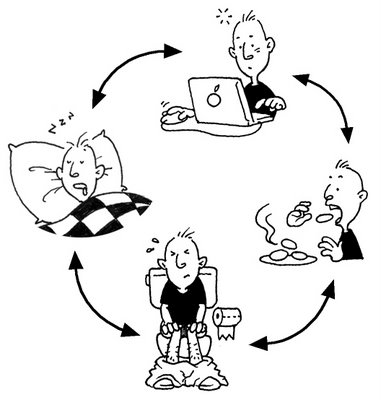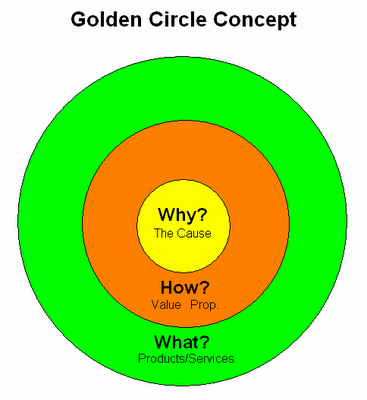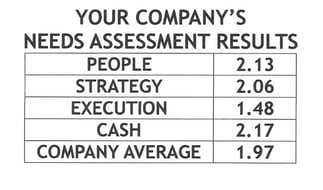Strategic Discipline Blog
Douglas A Wick
Recent Posts
Topics: employee engagement, Core Values, People, Core Purpose, Four Decisions, BHAG
In Four Decisions You Must Get Right to Achieve Growth I promised I’d provide you with a Personal Story about applying the One Thing principals. For a company example of One Thing, read this Blog from the Dream Manager. This story is about three years ago so as to provide some protection for my son Joshua. The point of sharing this is simple. Placing your primary focus on one thing, either for yourself or your company gets results. It’s extending the idea that less is more.
Topics: One Thing, Mastering the Rockefeller Habits, priorities
Last week I began work with a new client presenting a shortened version of the Two Day Rockefeller Habits Workshop. It occurred to me that many business owners and managers are unclear where they need to focus their attention to achieve results for their business.
Topics: One Thing, Four Decisions, Two Day Rockefeller Habits Workshop, Alignment
Michael Gerber Dreamed It Rockefeller Habits Checklist Quantifies It
Posted by Douglas A Wick on Thu, Jan 19, 2012
If you’re a small to mid-sized business owner you probably have a number of aspirations for your business. To build it so you can spend your time doing what you love most while the business runs consistently and predictably without you. Or it may be to watch it grow to achieve success humming along like a well-oiled machine. The dream of many small business owners was outlined in Michael Gerber’s book The E-Myth Revisited, Why Most Small Businesses Don’t Work and What To Do About It. Ultimately you want to be in a position to invest most of your time working ON the business rather than IN it.
Topics: measurement, Michael Gerber, Rockefeller Habits Checklist, consistently execute
Rip Van Winkle’s Leadership Lesson from Martin Luther King
Posted by Douglas A Wick on Sun, Jan 15, 2012
Remember the story of Rip Van Winkle? You probably remember he slept for 20 years, but little else.
Topics: Strategic Discipline, change, leadership, meeting rhythms, priorities, metrics
Recently I rediscovered the value of routine when I purchased a new computer. If you’ve had the occasion to move to a new computer recently perhaps you will recognize the disruptive forces that occur when suddenly you are without the use of your computer for several hours or in my case more than a day as your old data is restored to your new computer.
Topics: Accountability, meeting rhythms, Rockefeller Habits Checklist, routine
In your business do you place the highest priority on measuring performance and productivity? Sales revenue, units sold, profit margin, efficiency standards. Are these gold standard in your business?
Topics: Net Promoter Score, employee engagement, Core Values, employee performance, Core Purpose
Are you ready to get 2012 off to a roaring start? Would you like to get your team more inspired this year? Mike Schulte, Fleck Sales, earlier this year shared a video on what inspires your team. People don’t buy what you do; they buy why you do it. It’s the soft spot in your business that is frequently ignored or not valued as critically as is required. This subjective aspect of your business is included as Core Values, Core Purpose on your One Page Strategic Plan. They are often overlooked. Jim Collins in Built to Last, and Good to Great provided supportive proof that these elements are critical to business success. This video Simon Sinek: How great leaders inspire action offers insight into why you need the “WHY” in your business.
Topics: employee engagement, Core Values, Core Purpose, performance
Twelve tired, sweat covered young men shuffle through the hall toward a classroom. Each chooses a desk to sit in, plops themselves down for an unexpected respite from a grueling first week of basketball practice. The group looks around, engages in small talk, with one team member shouting out, “Wick, do you know what this is about?” I shrug my shoulders. It’s a first time experience for me as well as the rest of the team. Shortly thereafter, the new head coach enters his biology classroom where the boys have taken up temporary residence. Coach Belke strikes a commanding appearance. He’s about 6’2” with a barrel chest, large thick forearms, and looks every bit like the man who supposedly had a try-out with the Chicago Bears. Immediately the room falls silent, such is the presence he dictates. While Coach Belke has coached football and basketball before at Princeton High School, it’s been nearly a decade since he’s done either. He volunteered to take on the task of coaching basketball this year when our coach of the past three years unexpectedly left for a better teaching position. After years of dismal sports performances, this team is expected to do well. Our sophomore year our team won the first game a Princeton basketball team had won after 37 consecutive losses. The following year (our junior season) our team finished 13-6, 3rd place in the conference. Expectations are high.
Topics: planning, Annual Plan, strategy, Strategic Planning, Vision
Make Yourself, Employees and Customers Happier – Employee Engagement
Posted by Douglas A Wick on Sun, Dec 18, 2011
Did you realize when a customer says thanks, they make you happy, but they make themselves even happier. In her book The How of Happiness, Sonja Lyubomirsky, a professor at the University of California, Riverside, describes a dozen scientifically proven strategies to make yourself happier. The first? Expressing gratitude.
Topics: Employee Feedback, employee engagement, Switch, human behavior















.jpeg?width=150&height=135&name=Hand%20with%20marker%20writing%20the%20question%20Whats%20Next_%20(1).jpeg)

